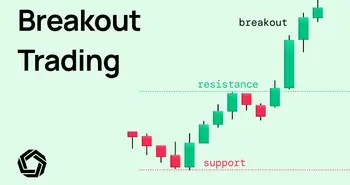Growth vs Value Stocks: Choosing the Right One for Your Portfolio
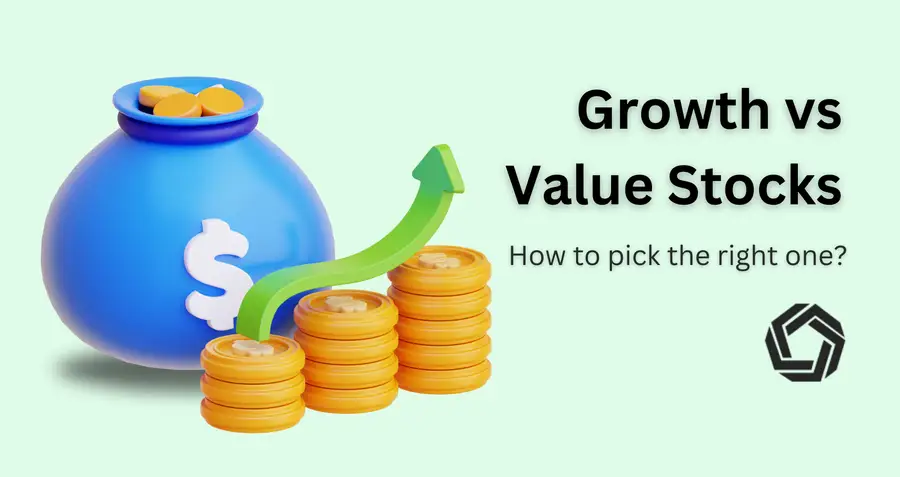
Choosing the right investments isn’t always easy. With so many options out there, it’s hard to know where to start. It’s not just picking what looks good, it’s about finding the assets that truly fit your goals.
In our recent guide on portfolio diversification, we talked about building a strategy that works for you. Are you chasing bold, short-term returns? Or are you all about steady, long-term growth? Every asset in your portfolio should have a job, working toward the goal you’ve set.
That’s where the growth vs. value debate comes in. These two types of stocks speak for a different crowd. But do not feel boxed in. This guide will break it down so you can figure out what works best for you.
What Are Growth Stocks?
Growth stocks represent companies that are all about potential. These are businesses reinvesting their profits to fuel expansion, rather than paying dividends to shareholders. You’ll often find them in industries driving innovation or disrupting the norm like tech, biotech, or renewable energy.
What makes growth stocks appealing? It’s their potential for significant price increases. Their value isn’t tied to current earnings but to what they could earn in the future. This optimism is why they often come with higher price-to-earnings (P/E) ratios. It’s an exciting space, but one that requires careful analysis to spot the real winners.

Examples of Growth Stocks
Let’s talk about some standout names that embody growth. In recent years, Nvidia has led the charge with its dominance in AI and gaming hardware, making it a prime example of a growth stock. Similarly, Tesla continues to drive innovation in electric vehicles and renewable energy solutions, often trading at sky high multiples due to investor optimism. Other examples include Amazon and Meta Platforms, which continue to push boundaries in their respective fields.
How to Pick Growth Stocks?
Finding the right growth stocks requires looking beyond the hype. Focus on:
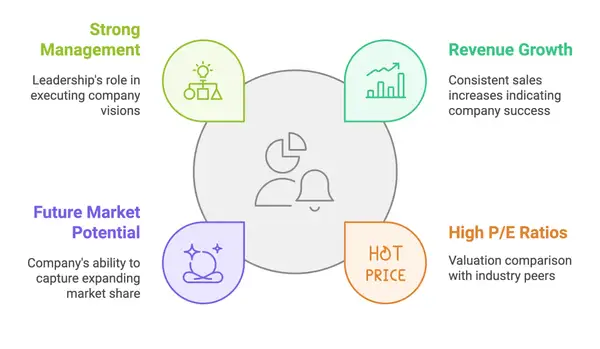
A Step-by-Step Guide with Nvidia as an Example
Revenue Growth
Nvidia’s revenue growth tells a compelling story. In 2024, the company reported an annual revenue of $60.922 billion, a 125.85% increase from 2023. Compare this to its 2023 revenue of $26.974 billion, which was relatively flat from 2022 at $26.914 billion, following a 61.4% surge in 2022. These numbers highlight Nvidia’s ability to capitalize on high-growth markets like AI and gaming. Consistent and rapid sales growth is a hallmark of successful growth companies.
High P/E Ratios
As of December 13, 2024, Nvidia’s price-to-earnings (P/E) ratio stands at 53.68. This is significantly higher than the market average, reflecting investor confidence in its future earnings potential. While high P/E ratios might seem daunting, they’re often justified for companies like Nvidia operating in high-demand, innovation-driven sectors. When evaluating growth stocks, compare their P/E ratios to average of the industry peers to ensure the valuation aligns with their market potential.
Future Market Potential
Nvidia’s dominance in AI hardware, data centers, and gaming makes it a leader in multiple booming industries. Its strategic focus on AI-related solutions positions it to capture even more market share as the demand for machine learning and advanced computing grows. Look for companies operating in industries with long-term, sustainable growth potential.
Strong Management
Visionary leadership can make or break a growth stock. Nvidia’s CEO, Jensen Huang, has been at the helm since its inception, driving the company’s innovation and strategic expansion. Companies with strong, experienced management teams are better equipped to execute bold visions and navigate competitive markets.
What Are Value Stocks?
If growth stocks are the sprinters of the market, value stocks are the marathon runners. These are established companies trading below their intrinsic value, often due to market inefficiencies. Value stocks are priced higher in relation to current earnings but may be discounted compared to their actual worth.
Unlike growth stocks, value stocks tend to come from more mature industries like utilities, banking, or consumer goods. Their allure lies in their stability, reliable cash flows, and often, their dividend payments (though not always).

Examples of Value Stocks
Famous examples of value stocks include Coca-Cola and Procter & Gamble, both of which operate in consumer staples, an industry that weathers economic ups and downs. Other examples include Johnson & Johnson, known for its diversified healthcare portfolio, and Berkshire Hathaway, Warren Buffett’s investment vehicle built on value principles.
How to Find Value Stocks
Finding value stocks requires a bit of detective work:
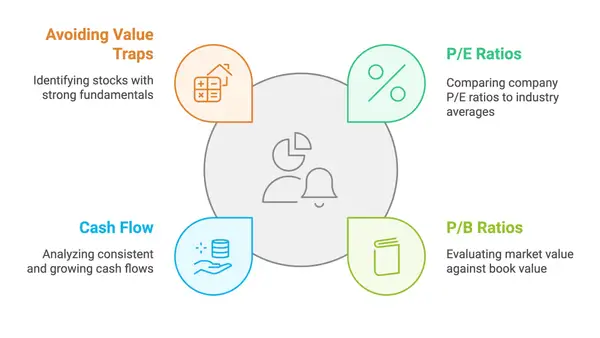
A Step-by-Step Guide with Pfizer as an Example
P/E Ratios
As of December 13, 2024, Pfizer’s P/E ratio stands at 9.91, well below the market average and its industry peers. This low ratio suggests that Pfizer may be undervalued relative to its earnings potential, a key indicator for value investors.
Price-to-Book (P/B) Ratios
Pfizer’s P/B ratio is 1.57, indicating it is trading close to its book value. For value investors, a low P/B ratio compared to competitors often signals that the stock is priced attractively in relation to the company’s assets.
Consistent Cash Flow
Pfizer has demonstrated strong cash flow over the years, with operating cash flow of $11.26 billion TTM (trailing twelve months). While its cash flow fluctuated during periods of high investment, the company maintains a solid free cash flow of $8.23 billion TTM. Strong cash flow supports the company’s ability to sustain operations, invest in growth, and reward shareholders.
Dividend Yield
Pfizer offers an attractive dividend yield of 6.57%, with an annual dividend of $1.68 per share as of December 13, 2024. For income-focused investors, a reliable dividend history is often a key component of value stocks. Pfizer’s consistent dividend payments make it particularly appealing to those seeking steady income alongside potential capital appreciation.
If you just needed a quick refresh and feel ready to dive in, there’s no need to wait. You can start trading growth or value stocks on Morpher with zero commissions. Or hesitant about picking a specific stock? Why not invest in an entire industry?
Morpher offers custom indices, including Tech, Biotech, AI, and more, giving you diversified exposure in just one trade. No matter your investor type, Morpher has something for you.
Ready to experience zero-commission trading? Start now on Morpher.

Growth vs. Value Stocks
If you’re still with us, let’s cut to the chase and highlight the main differences between growth and value stocks. Here’s a quick breakdown:
| Factor | Growth Stocks | Value Stocks |
|---|---|---|
| Focus | Future potential | Undervalued compared to current earnings |
| P/E Ratios | High | Low |
| Dividends | Rare | Common (but not guaranteed) |
| Risk | Higher volatility | More stable |
| Performance | Thrive in bull markets | Shine during economic recovery |
Growth vs. Value Stocks Historical Performance
Over the past decade, growth stocks have outperformed value stocks by a wide margin, a trend clearly visualized using index performance data. Growth focused companies, particularly in sectors like technology, AI, and consumer discretionary, have thrived, driven by innovation and years of low interest rates that fueled investor optimism.
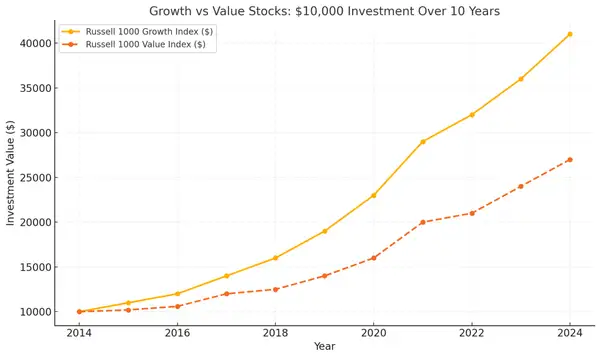
Meanwhile, value stocks have offered more stability, albeit with slower returns. The chart above reflects this performance over the last 10 years: growth stocks surged ahead, while value stocks followed a more gradual upward path.
However, it is worth noting that, today’s market looks different. With the economy teetering on the verge of a possible recession and interest rates remaining elevated, conditions are shifting. Historically, value stocks tend to outperform during economic recoveries and uncertain times, offering investors a sense of security with their steady fundamentals.
For investors, this means it’s time to pay attention to opportunities on both sides of the market.
Risk and Reward Trade-Offs
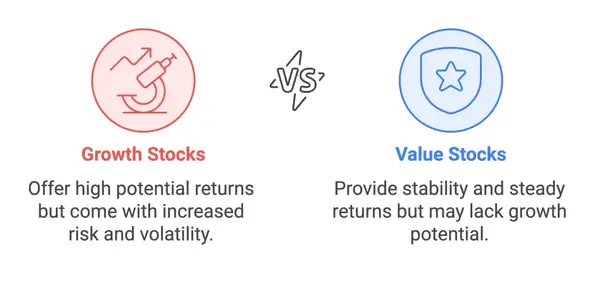
Why Dividends Can’t Be the Only Factor
Dividends often attract income-focused investors, but relying on dividends alone can have drawbacks:
- Tax Implications: Dividends aren’t “free money.” They are taxable income, which can erode your net returns, especially in higher tax brackets.
- Missed Growth Opportunities: Companies that prioritize paying dividends often reinvest less in innovation, research, and expansion. While dividends provide immediate income, reinvested earnings can fuel long-term growth, particularly for investors focused on capital appreciation.
- Market Volatility: Dividends are not guaranteed. During economic downturns, even well-established companies may be forced to reduce or eliminate dividend payouts, leaving income-focused portfolios exposed to risk.
For many investors, the trade-off is clear: dividends can offer stability and passive income, but they can also limit a company’s ability to grow. If you’re investing for long-term returns, focusing on companies with strong reinvestment strategies might unlock greater potential.
When they perform better?
Market conditions can dictate which stocks perform better:
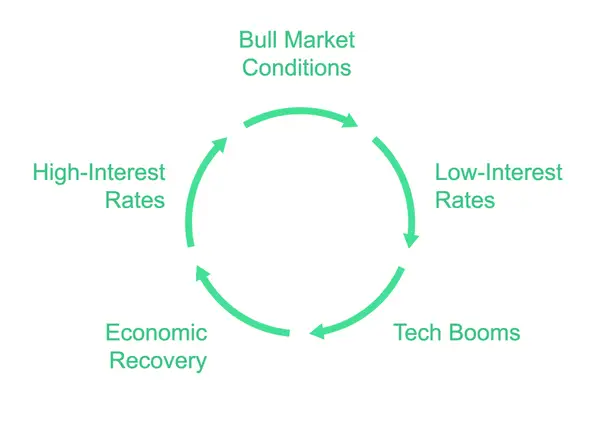
- Growth stocks shine in bull markets and low-interest-rate environments, where borrowing is cheap and investor confidence is high. Tech booms and innovation cycles favor growth stocks.
- Value stocks thrive in economic recovery and high-interest-rate conditions, where investors seek reliable, income-generating stocks. Think post-recession stability.
Which Is a Good Buy Now?
The answer depends on where we stand today and right now, we’re at a potential turning point. Despite persistent inflation and a resilient economy, the Federal Reserve is expected to cut interest rates for the third straight meeting. This could create a more growth-friendly environment, as lower interest rates tend to boost sectors driven by future potential, like technology, AI, and consumer discretionary.
Growth stocks have struggled with higher borrowing costs over the past couple of years, but rate cuts could reignite investor confidence, making them an attractive option for those seeking bold opportunities.
That said, value stocks shouldn’t be overlooked. Economic uncertainty, alongside geopolitical tensions, has investors eyeing financials, energy, and healthcare—sectors that offer stability and solid fundamentals, especially if a recession looms. Value stocks can serve as a safe harbor when volatility picks up.
The takeaway? Markets are in flux, and the outlook favors a flexible approach. If rate cuts unfold as expected, growth stocks may see renewed momentum, but combining them with value stocks can help you hedge against economic shifts.
Key Takeaways for Beginners
As a beginner, navigating the growth vs. value debate can feel overwhelming. No matter your strategy, staying adaptable is key. Morpher’s zero-commission trading lets you position yourself for both stability and opportunity. Here’s our recommendation:
- Start Small: Begin with companies you understand. Look into industries you follow or are passionate about.
- Diversify: Don’t put all your eggs in one basket. A mix of growth and value stocks can balance risk and reward.
- Leverage Technology: Use Morpher to fractionalize your investments, allowing you to invest in both types of stocks regardless of budget.
- Keep Learning: Monitor market conditions and adapt your strategy as you grow. The right mix today may not work tomorrow.
FAQ
1. What’s the difference between growth stocks and value stocks?
Growth stocks belong to companies expected to grow faster than the market average, often in innovative sectors like technology, AI, or biotech. Value stocks, on the other hand, are shares of companies considered undervalued compared to their fundamentals, offering slower, more stable returns.
2. Why have growth stocks outperformed value stocks in recent years?
Over the past decade, growth stocks have dominated due to low-interest rates, booming innovation, and investor optimism around future earnings. Sectors like tech and AI led the charge, delivering strong capital appreciation. However, market conditions change, and historically, value stocks have shined during economic recoveries or periods of rising interest rates.
3. Which is better: growth or value stocks?
There’s no one-size-fits-all answer—it depends on your goals and the current market. If you’re looking for higher returns and can tolerate volatility, growth stocks may suit you. If you prefer stability and a slower, reliable pace, value stocks are a better fit. A mix of both can help hedge against market uncertainty.
4. Can I trade both growth and value stocks on Morpher?
Yes! Morpher allows you to access and trade growth and value stocks with zero-commission trading. Whether you’re looking for fast-paced growth opportunities or stable, undervalued assets, Morpher gives you the flexibility to build a portfolio that matches your strategy.
5. How do interest rates impact growth and value stocks?
Lower interest rates tend to favor growth stocks because they reduce borrowing costs and boost investor appetite for future potential. On the other hand, rising interest rates often favor value stocks, as investors seek stability and companies with strong fundamentals.
6. Are value stocks better during economic recessions?
Value stocks often perform well during economic downturns and recoveries. They come from sectors like financials, energy, and industrials, which offer more predictable cash flows and lower valuations compared to high-growth sectors.
7. How can I decide which stocks to invest in?
Start by identifying your risk tolerance, investment timeline, and goals:
- Growth stocks: Higher risk, higher reward—suited for long-term investors seeking aggressive growth.
- Value stocks: Lower risk, steady returns—ideal for those looking for stability and undervalued opportunities.
Diversifying your portfolio with both strategies can provide balance and resilience in changing markets.
Final Thoughts
Both growth stocks and value stocks have their place in a solid portfolio—the balance is yours to decide. Whether you’re driven by risk, budget, or interest in specific sectors, Morpher lets you diversify your portfolio your way.
Access US growth and value stocks alongside global stock exchange indices, all on one platform with zero commissions. Ready to take the next step? Start now with Morpher.

Disclaimer: All investments involve risk, and the past performance of a security, industry, sector, market, financial product, trading strategy, or individual’s trading does not guarantee future results or returns. Investors are fully responsible for any investment decisions they make. Such decisions should be based solely on an evaluation of their financial circumstances, investment objectives, risk tolerance, and liquidity needs. This post does not constitute investment advice.

Painless trading for everyone
Hundreds of markets all in one place - Apple, Bitcoin, Gold, Watches, NFTs, Sneakers and so much more.

Painless trading for everyone
Hundreds of markets all in one place - Apple, Bitcoin, Gold, Watches, NFTs, Sneakers and so much more.




